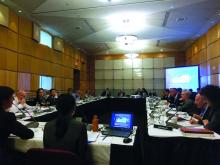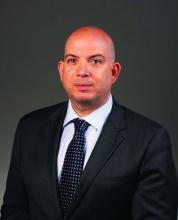WASHINGTON – Should Medicare abandon “incident to” billing for advanced practice registered nurses (APRNs) and physician assistants (PAs) as part of its move away from fee-for-service payment? Some of the experts on the Medicare Payment Advisory Commission think so.
A proposal presented at a recent MedPAC meeting would eliminate “incident to” billing – a payment policy under which an APRN or PA delivers the care but the claim is filed under a physician’s National Provider Identifier (NPI) and is paid at the Medicare physician fee schedule rate. Instead, APRNs and PAs would file claims under their own NPI and be paid at 85% of the physician fee schedule rate for any claims associated with an episode of care.
About 40% of evaluation and management (E&M) office visits conducted by APRNs on established patients were likely billed “incident to” in 2016, as were about 30% of such visits performed by PAs, MedPAC staff estimated.
“To put these numbers in context, we think that the rates of ‘incident to’ billing for NPs [nurse practitioners] and PAs mean that roughly 5% of all E&M office visits billed by physicians were likely performed by an NP or PA in 2018,” Brian O’Donnell, MedPAC policy analyst, told commissioners.
One reason for eliminating “incident to” billing is that it “obscure[s] the number of services actually furnished by NPs and PAs,” Mr. O’Donnell said. “Given the rapidly expanding number of NPs and PAs, Medicare’s ‘incident to’ rules could apply to an increasing number of services.”
MedPAC commissioner Kathy Buto, former vice president of global health policy at Johnson & Johnson, expressed support for the idea but raised a red flag that the system could be manipulated so that APRN/PA claims could still be paid at 100% of the fee schedule rate.
Commissioner Bruce Pyenson, principal and consulting actuary of Milliman in New York, suggested that APRN and PA claims should be paid at 100% of the fee schedule, mirroring other Medicare efforts to achieve site-neutral payments.
Similarly, commissioner Amy Bricker, vice president of supply chain strategy at Express Scripts, St. Louis, said that while she generally does not favor redistributing program savings, if APRN and PA claims were paid at 85%, the saving generated should go back to physicians who would otherwise lose money.
That change in revenue was a key concern for Michael Munger, MD, president of the American Academy of Family Physicians.
“We have a policy on ‘incident to’ billing at the academy,” Dr. Munger said in an interview. “It says that services that are delegated to and provided by nonphysician providers under physician supervision must be provided with the same quality and should be reimbursed at the same level as services directly provided by a physician.”
He said that lowering APRNs and PAs payments to 85% of what physicians make would impact doctors in a negative way, but if the elimination of “incident to” came with a recommendation that they be paid the same as physicians, it “would be less problematic.”
Dr. Munger described primary care as a team sport, and “this is certainly going to be felt in terms of the overall mission of delivering quality care.”
Access to care also could be reduced along with the reduced payment level, he added.
“You have to make business decisions at the end of the day,” he said. “You need to make sure that you can have adequate revenue to offset expenses, and if you are going to take a 15% cut in your revenue in, you have to look at where your expenses are, and obviously salary is your No. 1 expense. If you are not able to count on this revenue and you can’t afford to have NPs and PAs as part of the team, it is going to become an access issue for patients.”
Potential access and quality issues also resonated with the American Osteopathic Association.
“You really could see the elimination of the physician element from that practice environment and that would be to the detriment of patients,” David Pugach, AOA senior vice president of public policy, said in an interview. “Right now, you have the ability for incident billing, which requires the active participation of a physician in the management of patient care. If you end that practice, you are essentially removing the physician from the equation, and that really is an access issue; it’s a safety issue; and it’s a quality issue.”
He also noted that sometimes there is overutilization of diagnostic services with APRNs and PAs, and while costs may be saved by paying for those clinicians at less than the rate of physicians, the overutilization of other services by them could end up offsetting the savings.
“We have some significant concerns,” Mr. Pugach said.
The American Academy of Physician Assistants echoed some concerns expressed by MedPAC commissioners and staff.
“What we feel strongly about is the fact that one of the problems of ‘incident to’ is that it hides the practitioners, in this case the PA who actually renders the service,” Michael Powe, AAPA vice president of reimbursement and professional advocacy, said in an interview.
“We think that’s inappropriate for a number of reasons,” he continued. “Clearly from the issue of trying to figure who’s doing what, who saw the patient, what the quality of care happens to be, we think that PAs ought to be recognized ... and not hidden which happens under the ‘incident to’ methodology.”
He said that transparency helps determine where primary care needs are, whether they are being met, and it helps with determining network adequacy.
“So there are a number of good reasons why the accuracy and transparency should be there whether or not ‘incident to’ goes away.”
Jennifer Winter, committee chair for public education for the Society of Dermatology Physician Assistants, agreed.*
Eliminating “incident to” would grant greater visibility of PA practice “because right now, some of what we do is hidden by what the physician does” because it is billed under the physician and you can’t see what the PA is doing, especially if there is an adverse event, said Ms. Winter, who practices in Olympia, Wash. “It confounds trying to collect data on outcomes.”
She also noted that some physicians might not want to hire an NP or PA “because they can hire a physician and get 100%, but they are also going to have to pay that physician at a physician rate.”
Ms. Winter said that PAs and nurse practitioners should be getting 100% of the pay as they are doing essentially the same work that physicians would be doing.
MedPAC staffers also recommended that APRNs and PAs more clearly identify the specialty that they work in, something they do not currently have to do, to allow for more transparency and accurate data on the work that these types of clinicians are performing.
*An earlier version of this story misspelled Ms. Winter's name.




